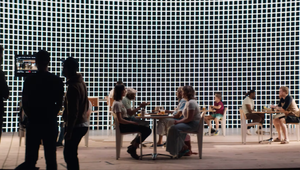
Virtual Production: Game or Gamechanger?

Ask anyone about virtual production and you’ll almost certainly get an answer which at some point will reference the Mandalorian. So synonymous are the two that nearly two million people have watched the ‘Making of’ film on YouTube. And they can’t all be Star Wars fans.
It’s certainly got people talking and thanks to the pandemic the decibel level has gone up a few notches in this last year. There’s more series in production, new studios popping up and new words in a producer’s lexicon like frustum and moire.
So, what’s all the fuss about?
Is virtual production, or more accurately put ‘In Camera VFX’ (ICVFX), just a long-form, big-budget thing? Or should even us producers and directors who have been weaned on smaller budgets and shorter shooting windows sit up and pay attention?
More importantly will it kill off the most fun part of our job, overseas all-expenses-paid breaks from the children, sorry I meant to say shoots! Is this the final nail in the fun coffin for short-form production as we all swap Palma for Park Royal?
A quick glance online and you can almost put your mind at rest. There’s lots of hype but little substance. Short of a few R & D test films and the odd car commercial there’s very little short-form ICVFX content and what is out there has certainly brought the pixel police out in force.
So we’re all good to jump back on the plane, right?
Well perhaps pause for a second and consider a few things.
Don’t worry I’m not going to give you a lecture on all the real-time tech and how it’s going to kill off green screen (there’s plenty of posts on this by far more qualified people). No, I think it’s worth looking at some of the people behind the tech and who’s driving this, because when all the major studios, platforms, equipment houses and gaming companies are investing billions into this, it’s probably good to be a bit curious.
First up Epic Games, the brand behind Fortnite who have quite literally revolutionised the gaming world and now they have us filmmakers in their sights. Virtual production is about the convergence of gaming technologies and filmmaking, the transfer of skills, technologies and innovations that to be honest we can’t afford. The folks at Epic are not only super smart people, they are very rich super smart people. So rich that in 2015, a year after they released Unreal Engine 4 they made it free for everyone. They enabled anyone and everyone to become CGI and game creators. And guess what? Millions did. And off the back of that they created the UE Marketplace, where artists and developers can sell their wares or should we say assets (with Epic taking just 5% of any sales).
So why is this relevant to us?
Well in a stroke this democratisation of technology created three of the four pillars required for virtual production: the technology, the talent and the assets, in the form of affordable and accessible CG worlds/environments.
CG 3D environments are important, but not essential, to fully utilise the real benefits of the virtual production volumetric stages. Fully immersive lighting from the scenes can be cheated but it’s better if you have a complete 3D scene and that doesn’t come cheap - or at least it didn’t.
But things are changing fast, as the world is quite literally being ‘megascanned’ and turned into one big giant 3D CGI model. Companies like Quixel and Turbo Squid are at the forefront of this, providing easily accessible assets for designers and developers.
If you don’t believe me Google ‘Unreal rural Australia’ or even better spend an afternoon going down the Unreal Marketplace rabbit hole and exploring this new universe. True it’s very ‘gamey’ still but it’s an incredible platform of creativity and talent.
In time, more and more ‘off the shelf’ photorealistic assets will become available and only get better. Currently certain elements work much better than others; interiors are good, nature is tricky while humans - or meta humans as they are known - look like they were made on a ZX 81.
This focus on filmmaking and enabling its creators sits at the heart of Epic's strategy and they are investing big money in this space (they have just raised US$1 billion to support future growth). This can only be a good thing as it will drive up the quality of talent and assets and ultimately make this technology more accessible to productions at both ends of the budget scale.
So it’s all looking promising on the software front, but what about hardware and in particular the accessibility and affordability of VP stages. Well, no surprises these volumetric spaces don’t come cheap and at the moment they are scarce. At last count London only had only three permanent stages online but they are popping up faster than you can say “what’s a frustum?” (Google it if you didn’t first time around!)
Demand from long form is fuelling this growth and the likes of Amazon, Netflix, Universal and Paramount all have stages in development. We’re following the lead of the US, where there’s over 100 planning applications in the pipeline. Whatever you think, this isn’t a passing trend.
More stages will obviously bring down the costs and critically upskill production crews in these new environments.
Of course, this whole technology is only as good as the people driving it, the talent.
And herein lies possibly the biggest limitation to this technology but also the biggest opportunity.
Please allow me to digress for a minute.
When I worked for an ad agency my kids thought my job ‘sucked’ (their quote). Ads are to kids what screens are to parents. Now I’m ‘OK’ (their quote again) as I work with lots of people making virtual worlds and they love that (I obviously don’t tell them that I do this to make ads still!). They are still at the Roblox/Minecraft level, but the next step up could be Unreal and this may be their door into our creative industry.
Today all a child or any budding artist/developer needs is a fast enough computer. This is the future not just for gaming but filmmaking as well. By democratising this technology, it doesn’t matter who you are, where you are from, how much money you have or what they look like, the door is open.
We are an industry rightly focussed on diversity and inclusion and herein lies a huge opportunity to enable the next generation of gamers/filmmakers to be a part of our industry.
The sooner we embrace this technology and what it has to offer the better.
It’s a new suite of tools that offers new opportunities for creatives and filmmakers in how to we make content. Every production role is still relevant and adaptable. These are skills and technologies that can complement our current ways of working and can even make them easier and better.
It’s certainly not a threat and let’s be honest a threat to what?
Every producer I know (me included) moans that production is a race to the bottom. We have to work miracles with smaller budgets, more ambitious creative, more channels and at the same time listen to a cacophony of client clichés like ‘thumb stopping’, ‘cut through’ etc.
In fact, the chances are you’re not on a plane to Palma, but you’re headed further east and you’re probably sitting amongst a Stag party back in Row 48! Park Royal doesn’t look so bad after all!
But seriously maybe it is time to try and do things differently.
Embrace innovation.
Take some inspiration from the hugely successful gaming industry.
This is an opportunity not a threat .
And soon it won’t be called virtual production, it will just be called production.










